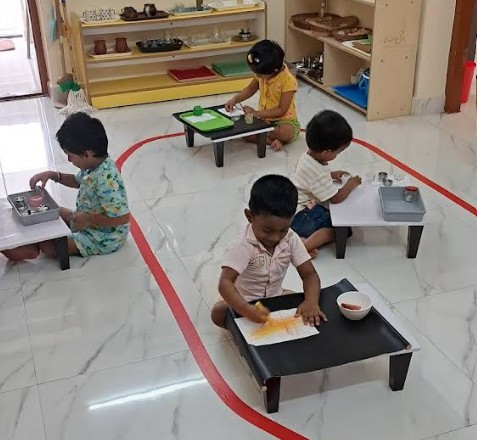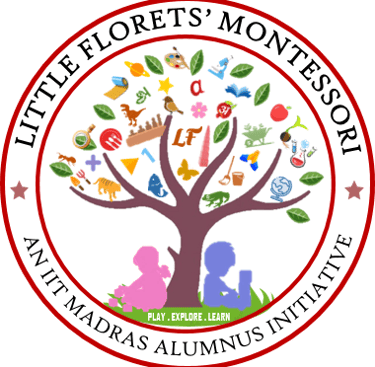Admissions open for YEAR 2026-27
Many Schools Call Themselves Montessori—How to Find the Right One
Not all schools that call themselves “Montessori” follow the true Montessori approach. In this post, we break down exactly what to look for when choosing an authentic Montessori school—from trained teachers and mixed-age classrooms to the prepared environment and respectful guidance. Whether you're just starting your research or visiting schools, this guide will help you ask the right questions and spot red flags with confidence.
PARENT RESOURCES
Little Florets' Montessori
3/22/20253 min read


Many Schools Call Themselves Montessori—How to Find the Right One
Today, it seems like almost every preschool is using the word Montessori. But did you know that “Montessori” isn’t a trademark? That means any school can use the name, even if it doesn’t follow the core principles of the Montessori method.
So how can you tell if a school truly offers an authentic Montessori experience for your child?
Here’s what to look for when visiting a Montessori school—and how to confidently choose the right one for your family.
1. Trained Montessori Teachers
A true Montessori classroom is led by a teacher who is specifically trained and certified in the Montessori method. This training goes far beyond a general teaching degree. Montessori teachers learn how to guide children based on their developmental needs, how to prepare learning environments, and how to nurture independence through observation rather than instruction.
Ask the school:
Are your lead teachers certified by a recognized Montessori organization like AMI (Association Montessori Internationale) or AMS (American Montessori Society)?
How long was their training, and what age group is it focused on?
Certification matters. It ensures that the teachers understand the method deeply and are equipped to implement it effectively.
2. Prepared Learning Environment
An authentic Montessori classroom is carefully designed to support independent learning. This is known as the prepared environment, and it’s one of the most important parts of Montessori education.
Look for:
Child-sized furniture and accessible shelves
Natural materials (wood, metal, glass) instead of plastic toys
Beautifully arranged learning materials with a clear purpose
Calm, orderly, and clutter-free spaces
Every material in a Montessori classroom is thoughtfully placed to invite exploration, hands-on learning, and focus. If the classroom looks chaotic or resembles a traditional playroom, it may not be truly Montessori.
3. Mixed-Age Classrooms
Montessori classrooms are designed for three-year age groupings, such as:
3–6 years (Primary)
6–9 years (Lower Elementary)
9–12 years (Upper Elementary)
This structure allows younger children to learn by observing older peers and older children to develop leadership and confidence through mentoring. It also promotes a more natural, community-like environment.
If children are grouped by single age or frequently move between classrooms, the program may not be following Montessori principles.
4. Freedom Within Limits
Montessori classrooms give children freedom to choose their work, move around the room, and explore their interests—but always within clear, respectful boundaries.
Here’s what to expect:
Children independently selecting materials and working at their own pace
A calm, purposeful atmosphere
Teachers observing quietly and stepping in only when needed
Gentle redirection and clear classroom rules
This balance of freedom and structure is a hallmark of the Montessori method. It helps children build responsibility, self-discipline, and confidence.
5. Uninterrupted Work Periods
Authentic Montessori classrooms offer long, uninterrupted work cycles—usually 2 to 3 hours in the morning. This allows children to:
Focus deeply on their chosen activity
Repeat and master skills
Transition naturally between areas of interest
If a school’s schedule is broken up by frequent transitions, group activities, or short lessons, it may not support the kind of concentration that Montessori fosters.
6. Respect for the Child
At the heart of Montessori is a profound respect for each child’s unique personality, pace of development, and inner potential.
In a Montessori environment, you should see:
Teachers speaking gently and respectfully to children
Children confidently managing tasks like pouring their own water or cleaning up after snack
A peaceful classroom where children are not rushed, pressured, or frequently interrupted
This respectful approach helps children feel safe, capable, and valued.
Questions to Ask When Touring a Montessori School
When visiting a school, don’t hesitate to ask questions like:
Are your lead teachers Montessori-certified? By which organization?
What is a typical day like in your classrooms?
Can I observe a class in session?
What kind of materials do you use, and how are they introduced?
How do you support a child’s independence?
How do you approach discipline and behavior guidance?
The answers will help you get a clear picture of how closely the school aligns with Montessori principles.
Red Flags to Watch For
Keep an eye out for these signs that a school may not be truly Montessori:
No certified Montessori teachers
Lack of authentic Montessori materials
All children doing the same activity at the same time
Frequent use of plastic toys, worksheets, or screens
No mention of mixed-age classrooms or long work cycle
Final Thoughts
Choosing a Montessori school is about more than the name—it’s about the philosophy, the environment, the training, and the respect for your child’s natural development. When you know what to look for, the right school will stand out clearly.
If you're considering Montessori for your child, take your time, ask questions, and trust your instincts. A truly authentic Montessori environment will feel calm, purposeful, and deeply respectful of the child.



